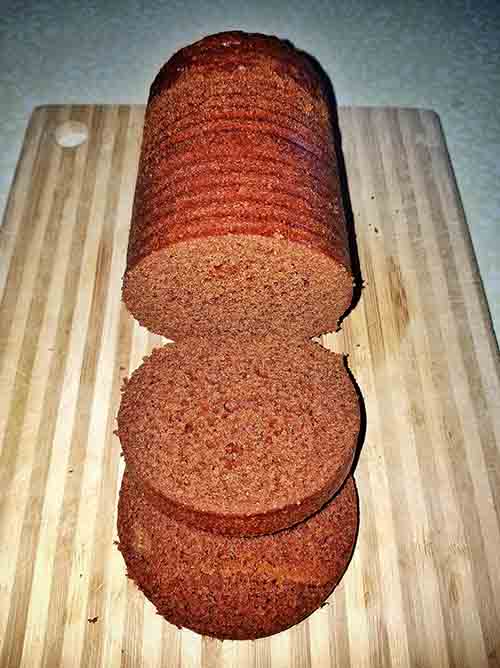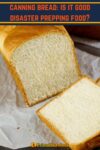Canned bread is getting popular with preppers, so we decided to give it the once over and see what it’s all about.
We’ll be covering the following:
- What canned bread is
- Shelf life
- Suitability for a disaster food stockpile
- Alternatives
What Is Canned Bread?
Canned bread is a type of shelf-stable bread. It is typically made with wheat, rye, and corn flour, as well as a lot of molasses.
The molasses gives the bread acidity, which allows it to be canned safely. It is popular in Boston and other parts of New England, traditionally eaten with baked beans.
In the United States, B&M is the only brand making canned bread (that I’m aware of, at least!). You can get it on Amazon or at most supermarkets.
Origins of Canned Bread
Canned bread dates back to the 17th century in New England. Colonists during this time typically did not use ovens. So, to make bread, they would put the dough in a coffee can and steam it over an open fire. This type of canned bread was not shelf-stable, though.
It’s not clear when the first shelf-stable canned bread appeared. It was likely in the 1920s when the brand B&M made canned bread to sell alongside their canned beans. Canned bread was also regularly included in soldier rations during WWII.
What Does Canned Bread Taste Like?
Compared to a loaf of white bread, canned bread is very dense and thick. The texture is more like a muffin or a cake. Because it contains molasses, canned bread is also very sweet.
Because canned bread is so sweet, you probably don’t want to use it to make sandwiches. It’s better as a dessert or sweet breakfast bread. The sweet taste also pairs well with baked beans, ham, and hot dogs.
Canned bread tends to be a bit dry, so you’ll want to eat it with something moist. Many people love to eat it slathered with cream cheese, jam, honey, or butter (you can get powdered butter for your emergency preps).

How to Eat Canned Bread
Just open the can and turn it upside down to remove the bread. Then you can slice it and eat it. However, if you really want to take things to the next level, try this:
- Open the can lid or poke a hole in it. Then steam the can in a pot of boiling water to heat the bread. Remove the bread, add toppings and enjoy. OR
- Grill or toast slices of canned bread. It intensifies the molasses taste and makes it even more enjoyable.
But, whatever you do, DO NOT MICROWAVE canned bread. It ends up soggy and with a peculiar taste.
Shelf Life of Canned Bread
B&M canned bread has a date of two years from the date of manufacture. However, this is just the “best by” date: canned bread will last much longer than this and still be safe to eat. Experts typically put the shelf life of canned bread at around 10 years.
There are also plenty of anecdotal reports of people eating B&M bread years past its best-by date, and the bread still tasted the same, albeit maybe a bit drier. And there’s also a report from 2002 of a man finding a box of canned bread from WWII. The bread was analyzed and deemed “still edible.”
Is It a Good Prepping Food?
Canned bread is a good prepping food because it is shelf-stable. It also doesn’t require any preparation, which is ideal for many disaster situations, such as:
- When you can’t bake bread: Such as if a gas leak is suspected and it isn’t safe to light a fire, or during heat waves where it is too hot to bake.
- You want to conserve fuel: Baking bread takes a lot of fuel, and that fuel probably has many better uses.
- Short-term emergencies: Such as winter power outages, where you wouldn’t necessarily want to open stockpiles of food meant for long-term emergencies or bother setting up your emergency stove.
In a SHTF situation, canned bread would also make a great barter item since most people wouldn’t have the means to make their own bread.
However, canned bread is not suitable for all types of disaster scenarios. It is heavy and bulky, so not an ideal food for bug out bags. It’s also much more expensive to buy canned bread than stockpile ingredients for making your own bread, so not ideal for long-term stockpiles of food.
Is It Possible to Make Your Own Canned Bread?
The canned bread recipes you find online are not for shelf-stable bread. Instead, these are for bread you cook in a can or jar and eat immediately.
It is also impossible to can your own bread at home: the risk of botulism poisoning is too high. American-style bread isn’t acidic enough to be safely canned.
Even if you used acidic breads, you’d still need to heat them to very high temperatures to ensure botulism was killed. This isn’t possible in home conditions.
Pilot Bread vs. Canned Bread
Pilot bread is also a shelf-stable carbohydrate suitable for disaster prepping. However, despite its name, pilot bread is not bread. It is dense and crispy, like a cracker. Note that pilot bread is just another name for hardtack.
Alternatives to Canned Bread
The best alternative to canned bread for prepping is to learn how to make bread and have the means to do so in an emergency.
This means things like storing yeast, knowing how to make wild yeast, and how to make bread without yeast. You’ll also need an emergency oven, such as a good solar oven or wood stove.
But, as mentioned before, it’s not always practical to bake bread during emergencies. Instead, you can stockpile one of these alternatives to canned bread:
- Pumpernickle or Volkorenbrot: These are German-style breads with a long shelf life. They typically last at least a year without any special storage. The brand Mestemacher is good.
- Freeze dried bread: You can sometimes find this at Walmart and emergency food companies. Or you can get a home freeze dryer and do it yourself. The bread can be rehydrated by putting a wet towel on top of it and waiting.
- Carbohydrates that don’t require cooking: It isn’t bread, but a lot of carbs can be made by just adding water and letting them soak. These include instant mashed potato flakes, couscous, ramen noodles, and freeze-dried sweet potatoes.
https://www.reddit.com/r/preppers/comments/6tpbfp/cheap_shelf_stable_bread/https://www.reddit.com/r/StupidFood/comments/mlc2md/canned_bread/
https://www.reddit.com/r/preppers/comments/t7jyh7/are_we_there_yet/
https://forums.thesurvivalpodcast.com//index.php?topic=7534.0
https://www.chicagotribune.com/dining/recipes/ct-food-0401-brown-bread-20150403-column.html
https://shop.conserva.de/en/content/16-haltbarkeit-von-konserven




The canned bread is a PUFA nightmare!